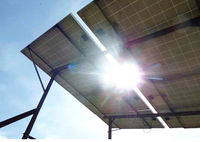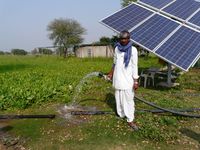Difference between revisions of "SPIS Toolbox - The Solar Alternative"
***** (***** | *****) |
***** (***** | *****) m |
||
| (3 intermediate revisions by 2 users not shown) | |||
| Line 7: | Line 7: | ||
| {{Back to Get Informed}} | | {{Back to Get Informed}} | ||
| | | | ||
| − | | style="width: 150px; background-color: rgb( | + | | style="width: 150px; background-color: rgb(111, 142, 43);" | <span style="color: rgb(0, 0, 0);"><span style="font-size: 90%;"><span class="link2">'''[[SPIS Toolbox - Specifics of Solar Energy|►Go to the Next Chapter]]'''</span></span></span> |
|} | |} | ||
| Line 27: | Line 27: | ||
But there are more advantages to the environment. A solar system that replaces a typical diesel generator unit will save about 1 kg of CO2 per kilowatt hour of output. This already takes emissions during the lifecycle of the PV system into account. Moreover, PV-powered water pumping also helps to avoid the danger of soil and ground water contamination with fuels and lubricants. A diesel engine produces about 300 kg of waste oil over its lifetime. An environmentally sound disposal of this waste is not guaranteed everywhere. On the other hand, due to the unlimited supply of sun for pumping, there is a risk of over-pumping surface and groundwater resources if systems are not adequately sized and planned (see '''[[SPIS Safeguard Water|SAFEGUARD WATER]]''' module).<br/><br/>{{SPIS Reference}}<br/> | But there are more advantages to the environment. A solar system that replaces a typical diesel generator unit will save about 1 kg of CO2 per kilowatt hour of output. This already takes emissions during the lifecycle of the PV system into account. Moreover, PV-powered water pumping also helps to avoid the danger of soil and ground water contamination with fuels and lubricants. A diesel engine produces about 300 kg of waste oil over its lifetime. An environmentally sound disposal of this waste is not guaranteed everywhere. On the other hand, due to the unlimited supply of sun for pumping, there is a risk of over-pumping surface and groundwater resources if systems are not adequately sized and planned (see '''[[SPIS Safeguard Water|SAFEGUARD WATER]]''' module).<br/><br/>{{SPIS Reference}}<br/> | ||
| − | |||
{{SPIS Reference}} | {{SPIS Reference}} | ||
| − | |||
{| cellpadding="1" | {| cellpadding="1" | ||
| Line 38: | Line 36: | ||
| {{Back to Get Informed}} | | {{Back to Get Informed}} | ||
| | | | ||
| − | | style="width: 150px; background-color: rgb( | + | | style="width: 150px; background-color: rgb(111, 142, 43);" | <span style="color: rgb(0, 0, 0);"><span style="font-size: 90%;"><span class="link2">'''[[SPIS Toolbox - Specifics of Solar Energy|►Go to the Next Chapter]]'''</span></span></span> |
|} | |} | ||
Latest revision as of 15:15, 21 July 2020

| ►Back to the Start Page | ►Back to the Module Page | ►Go to the Next Chapter |
1.1 The Solar Alternative
If traditional pumping technologies, such as manual or animal-powered pumps, reach their technical limits, the customary means of pumping irrigation water are diesel-, gas- or petrol-driven pumps. Such conventional pumps, however, have the double drawback of requiring a lot of maintenance as well as a regular supply of fuel and physical attendance for operation. Particularly in remote areas of developing countries, access to spare parts, maintenance structures or fuel can be limited, leading to frequent outages of several days or longer.
The resulting lack of water can result in yield reduction or failure, and thus poses a great risk for the agricultural enterprise.
In non-electrified parts of the world, solar energy could help to provide access to an environmentally sound and reliable energy supply. Especially in developing countries, the perspective of grid extension and the establishment of a reliable, uninterrupted electricity supply into rural areas is still a remote prospect. Rural electrification in economically weak rural areas of Africa, Asia and Latin America will be largely based on investments into local off-grid solutions for basic consumptive household electrification, with little consideration for productive uses of energy.
With the right knowledge on proper operation and maintenance of solar photovoltaic pumps, failures are much less likely than with conventional pumping systems.
Solar pumps for irrigation have been gaining importance since 2010. India, for example, has a large SPIS technology market. There are more than 12 million electric and 9 million diesel irrigation pump sets in operation to provide water for about 39 million hectares of irrigated land. If only 50% of these diesel pumps were replaced with solar PV pump sets, diesel consumption could be reduced in this area to about 225 billion liters per year.
But there are more advantages to the environment. A solar system that replaces a typical diesel generator unit will save about 1 kg of CO2 per kilowatt hour of output. This already takes emissions during the lifecycle of the PV system into account. Moreover, PV-powered water pumping also helps to avoid the danger of soil and ground water contamination with fuels and lubricants. A diesel engine produces about 300 kg of waste oil over its lifetime. An environmentally sound disposal of this waste is not guaranteed everywhere. On the other hand, due to the unlimited supply of sun for pumping, there is a risk of over-pumping surface and groundwater resources if systems are not adequately sized and planned (see SAFEGUARD WATER module).
| ►Back to the Start Page | ►Back to the Module Page | ►Go to the Next Chapter |






















